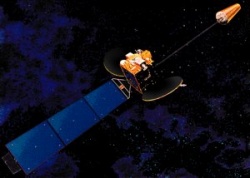If you wish to contribute or participate in the discussions about articles you are invited to contact the Editor
MSAS Space Segment
| MSAS | |
|---|---|
| Title | MSAS Space Segment |
| Author(s) | GMV. |
| Level | Basic |
| Year of Publication | 2011 |
The Multi-functional Satellite Augmentation System (MSAS) is the Japanese SBAS System: a GPS Augmentation system with the goal of improving its accuracy, integrity, and availability, and that uses the Multifunctional Transport Satellites (MTSAT). Tests during Initial Operational Phase were accomplished successfully, and MSAS for aviation use was declared operational on September 27, 2007.[1]
GPS signals are received at the MSAS Ground Monitor Stations and MSAS Monitor & Ranging Stations. These stations check operational status of GPS, and transmit GPS data to Master Control Stations that analyze GPS error and ionospheric delay. Then, these Master stations compute Augmentation information and broadcast it to GEO MTSAT (Multi-functional Transport Satellite)[2] satellites. Those satellites, MTSAT, rebroadcast the correction messages back to Earth, where MSAS-enabled GPS receivers use the MSAS corrections to compute a reliable and accurate position.
MSAS Space Segment
The space segment consists of two geosynchronous communication satellites (GEO): the Multifunctional Transport Satellites (MTSAT), with navigation payloads which broadcast the correction messages generated by the Master Stations for reception by the User segment. These two satellites are not only devoted to navigation, but also to meteorological/weather purposes.
MTSAT are owned and operated by the Japanese Ministry of Land, Infrastructure and Transport and the Japan Meteorological Agency (JMA), and provide coverage for the hemisphere centred on 140° East (including Japan and Austrilia, the main users of the MTSAT images). Besides being the Space Segment of the Japanese MSAS Augmentation system, the MTSAT satellites provide imagery in five wavelenght bands for weather functions.
MTSAT-1R (also known as Himawari 6) was successfully launched on a H-IIA on February 26, 2005. It was built by Space Systems/Loral. MTSAT-2 (also known as Himawari 7) was built by Mitsubishi and successfully put in orbit on February 18, 2006. Their lifespan is planned to five years) [2]. Both satellites, MTSAT-1R and MTSAT-2, are controlled by Kobe MCS station and Hitachiota MCS, respectively. The main characteristics of MTSAT satellites are shown in next table (table taken from MSAS article in Wikipedia):[1]
| Satellite Name & Details | NMEA / PRN | Location |
|---|---|---|
| MTSAT-1R | NMEA #42 / PRN #129 | 140°E |
| MTSAT-2 | NMEA #50 / PRN #137 | 145°E |

